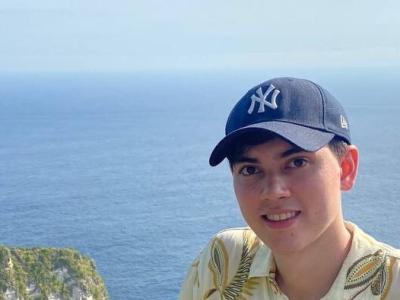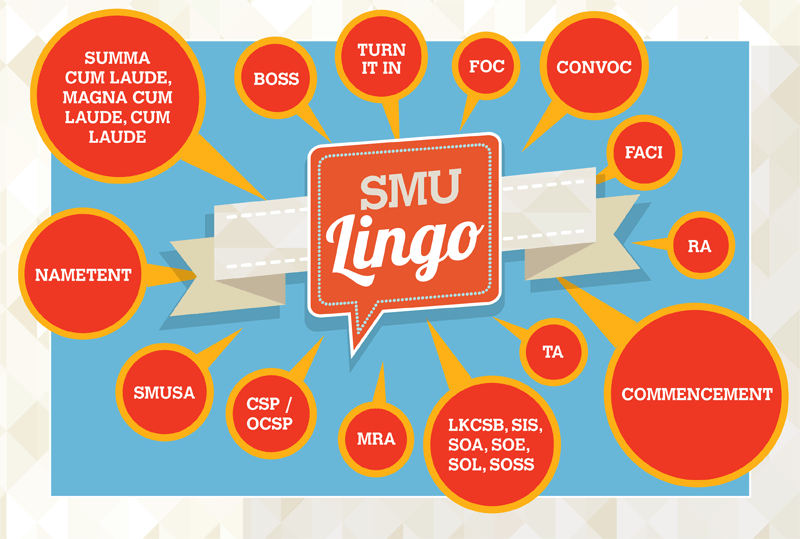
Much like cosmopolitan Singapore’s unique brand of Singlish, our community here at SMU has concocted a few terms that will seem foreign to any outsider. Our students and faculty throw around these jargon terms on a daily basis – sometimes (subconsciously) even at unsuspecting non-SMU individuals.
If you’re matriculating to SMU or coming here for an international exchange programme, here is a handy guide to some of our most commonly-used acronyms and terms.
1. Schools
The names of our six schools at SMU are all a bit of a mouthful. That’s why each school’s full name is rarely used, except perhaps when students are filling up an official document. Otherwise, we conveniently use the respective schools’ acronyms.
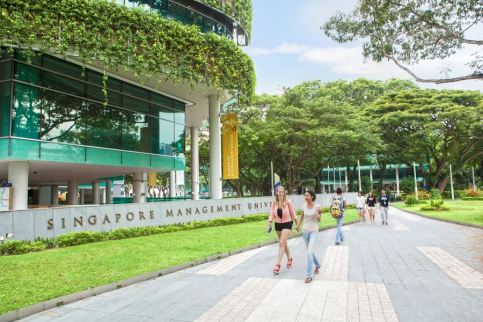
In my opinion, only one school’s acronym requires explanation. We all know that the official name of SMU’s business school is Lee Kong Chian School of Business. But apparently, we find LKCSB a mouthful, so we just resort to SOB instead. The other five schools are pretty much straightforward: SOL for Yong Pung How School of Law, SOA for School of Accountancy, SCIS for School of Computing and Information Systems, SOSS for School of Social Sciences, and SOE for School of Economics.
2. Location references
Sometimes you need to get to a talk/meeting/out-of class activity that isn’t held in a specific school. Be careful when you ask for directions from an SMU native, you may get an alien term in response. Or worse: even more acronyms.
To get around campus, it’s useful to know that the underground (i.e. Concourse) life is equally if not more bustling than the life above ground. The Concourse level is home to a few notable landmarks where a great deal of student life takes place: the Big Steps and the T-Junction.
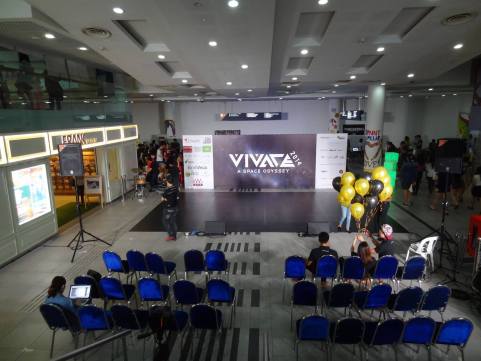
The T-Junction during Vivace 2014. (Bonus definition: Vivace is SMU’s annual CCA fair, which showcases our vibrant student life.)
The Big Steps is a long flight of stairs which links the basement of SIS to the first floor. Its primary function, however, is as a seating space for use when there are events held at the bottom of the steps. The other noteworthy underground location is the T-Junction. Located near the Bras Basah MRT exit, in between FRANK by OCBC and Loaves Me, it’s a pedestrian intersection where students gravitate towards in between their classes.
At street level, the only other place that’s a student activity hotspot is the Campus Green. Sandwiched in between the library and SIS, Campus Green is our go-to place for activities that require a large space. It is also the closest thing to a sports field that we can call our own.
As a result of our unique seminar-style class format, SMU only has two auditoriums for lectures and talks: NAKA, short for the Ngee Ann Kongsi Auditorium, and MRA, short for the Mochtar Riady Auditorium. They are located at SOL/SOA and the Admin Building respectively.
(May 2016 update: As you roam around campus this year, you may notice a number of hoardings and construction work going on. If you don’t already know, SMU is in the process of further enhancing our city campus. Check out some of the spanking new developments coming your way very soon.)
3. Events and activities
If you’re an incoming freshman, you’ll probably hear ‘convoc’ a lot, especially during the pre-school camp season.Convoc is short for convocation, SMU’s official welcome event for all incoming students.

Happy faces at SMU Convocation 2014.
Speaking of camps, freshmen will also often come across the term FOC. Short for Freshman Orientation Camp, FOC is a compulsory camp for all freshmen, where you’ll get to meet new friends and get to know more about SMU. Along your SMU journey, you’ll also take part in at least 80 hours of local and overseas community service projects, commonly referred to as CSPs and OCSPs respectively. Find out more about SMU’s culture of community service here.
(May 2016 update: Check out this page for a full list of freshmen camps for 2016)
4. Academics
Once you begin your first semester, you’ll need to learn yet more terms that will be used by profs and fellow students alike.
We’ll start with the jargon that needs no introduction – the Boss. Nope, here in SMU, Boss is not a superior, authoritative figure – not literally at least. It actually is the platform every student has to use to bid for the coming semester’s modules, (yes, that also includes clueless incoming freshmen).
Whilst on the topic of online software, another academic term to grasp is Turn It In, an online software that checks a report or essay for plagiarism.
5. People
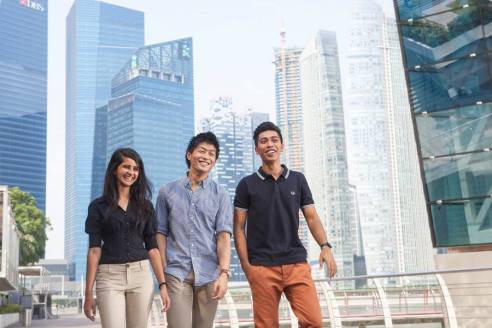
The last set of terms you’ll need to be equipped with for your SMU journey are those related to the various people you’ll meet. The main ones who help incoming freshmen to acclimatise to SMU are their facis, short for facilitators. You’ll meet them during the various camps for freshmen that take place before your first semester. More often than not, facis come in pairs – one guy, one girl – and are in their second year of study.
Once school starts, however, the people you’ll look to as your mentors will be the Teaching Assistants. Professors and students alike conveniently refer to them as TAs, and their role is to help lighten the profs’ admin load. Another (more elusive) group would be the RAs, or the Research Assistants. As the title suggests, they’re students who assist the faculty members with research-related work.
If you encounter any other unfamiliar terms along the way, don’t hesitate to ask a friendly senior! Leave a comment here to share more jargon and definitions with your fellow SMUdents.
This article was originally published on The SMU Blog.


